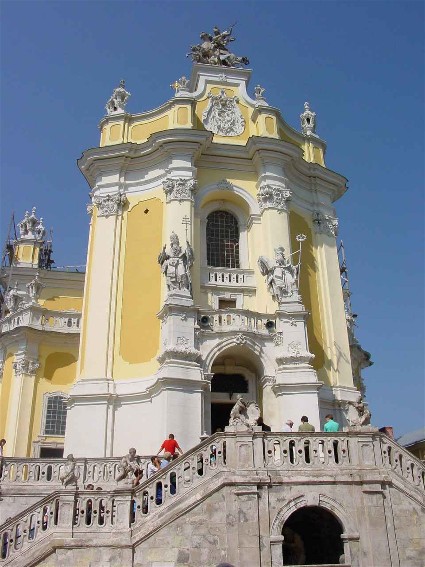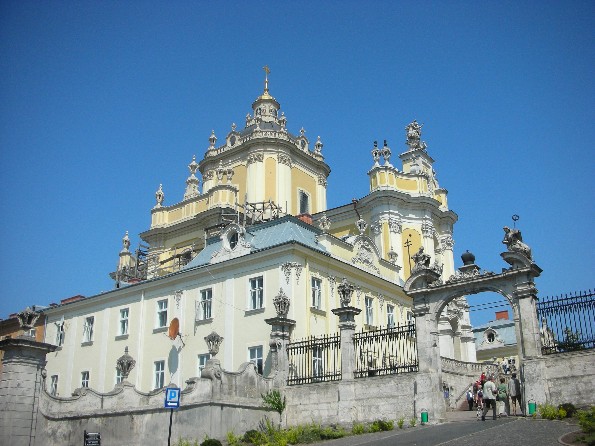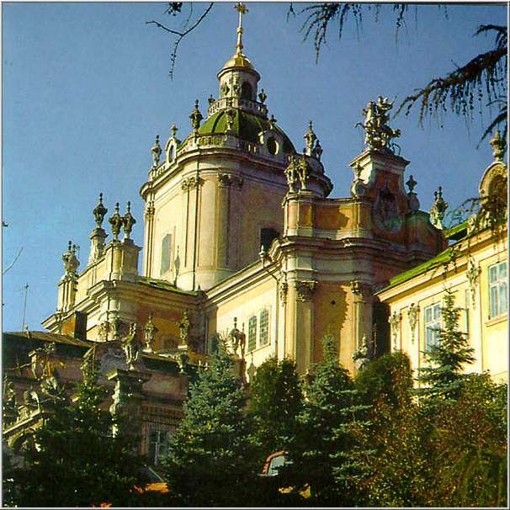Saint George's Cathedral
Saint George's Cathedral (Собор св. Юра; Sobor sv. Yura). One of the finest examples of rococo church architecture in Europe, built in Lviv. From 1817 to 1946 it served as the seat of the Ukrainian Catholic Halych metropoly. The cathedral's complex, consisting of the church, the campanile (its bell was made in 1341), the metropolitan's palace, office buildings, a wrought-iron fence, two gates, and a garden, stands on a high terrace overlooking the old city of Lviv. According to legend the site of the complex was originally occupied by a wooden church and a fortified monastery founded ca 1280 by Prince Lev Danylovych and, after their destruction by King Casimir III the Great (in 1340), by a three-apse, four-column Byzantine stone basilica (1363–1437). Under Metropolitan Atanasii Sheptytsky the basilica was dismantled and under Metropolitan Lev Sheptytsky it was replaced with the present church, which was designed by and built under the direction of Bernard Meretyn in 1744–59 and finished in 1764 by S. Fessinger, who also built the adjacent metropolitan's residence (1761–2).
Built on a cruciform ground plan, the four-column church is topped by one large cupola and four small ones. The high exterior walls are decorated with simplified Corinthian pilasters, rococo stone lanterns, and a cornice. Two stairways with delicate rococo balustrades lead to the main entrance, which is flanked by statues of Metropolitans Atanasii Sheptytsky and Lev Sheptytsky. Above the entrance is a balcony, a high window, the coat of arms of the Sheptytsky family, and an attic surmounted by a statue of Saint George the Dragon Slayer by Johann Pinzel. The grounds in front of the church are enclosed by two rococo gates decorated with allegorical figures of Faith, Hope, and the Roman and Greek Catholic churches.
The church's interior decorations were completed only in 1790. The paintings were done by masters such as Yurii Radylovsky (Archpriest and Appearance before the Apostles), M. Smuhlevych (Christ's Sermon, behind the altar, and Christ Pantocrator, in the dome), and Luka Dolynsky (local icons, oval icons of the prophets, and scenes of 16 feast days). The sculptured frame of the two entrance doors, the decorations around the entrances, and the many lanterns were done by Mykhailo Filevych. In 1942 Mykhailo Osinchuk restored the paintings and repainted the frescoes. With the suppression of the Ukrainian Catholic church by the Soviet regime in 1946, the cathedral was placed under the jurisdiction of the Russian Orthodox church. With renewed religious freedom in the early 1990s, the cathedral reverted to the Ukrainian Catholic church.
BIBLIOGRAPHY
Mańkowski, T. Lwowskie kościoły barokowe (Lviv 1932)
Sichyns’kyi, V. Arkhitektura katedry sv. Iura u L’vovi (Lviv 1934)
Lohvyn, H. Po Ukraïni (Kyiv 1968)
Ovsiichuk, V. Arkhitekturni pam'iatky L’vova (Lviv 1969)
Sofiia Yaniv
[This article originally appeared in the Encyclopedia of Ukraine, vol. 4 (1993).]
.jpg)

.jpg)
.jpg)

